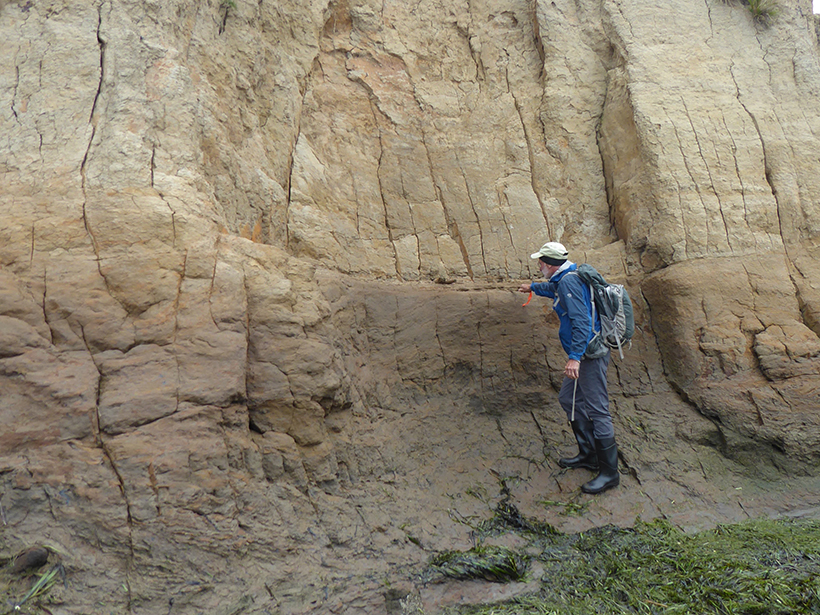Subduction zone earthquakes are among the most impactful natural hazards on Earth.
The Cascadia Subduction Zone (CSZ) of the U.S. Pacific Northwest and coastal British Columbia, Canada, experienced in prehistory numerous great megathrust earthquakes, which are defined as magnitude 8.0 and larger. Future earthquakes are inevitable, and their effects could cripple the region. Despite substantial knowledge gained from decades of geoscience research, estimates of the sizes and frequencies of Cascadia earthquakes remain uncertain.
Earthquake cycle models are commonly invoked along subduction zones, and earthquakes repeat with some degree of regularity from tectonic loading and release. However, estimated recurrence intervals of past Cascadia megathrust earthquakes vary substantially, and statistical and computer models suggest event clustering behavior.
Much of the current understanding of Cascadia earthquake hazards comes from evidence found in onshore and marine geologic records and from modern recurrence in other subduction zones. Differences between geologic records might be related to their sensitivity as earthquake recorders (i.e., “evidence thresholds”). For example, the occurrence and preservation of coseismic coastal subsidence depends on several parameters, including rupture extent, slip distribution, and interevent coastal uplift. Similarly, offshore turbidite records depend on the frequency and extent of ground motion shaking during past Cascadia earthquakes, as well as on sediment availability.

The U.S. Geological Survey (USGS) Powell Center for Analysis and Synthesis Cascadia Earthquake Hazards Working Group was formed to synthesize geological and geophysical information relevant to CSZ megathrust earthquakes.
Participants include a diverse range of researchers, from early-career scientists to emeritus experts in tectonics, geophysics, crustal structures, landslides, sedimentology, paleoseismology, land level changes, geodesy, mantle and crustal rheology, and earthquake rupture dynamics. Throughout the first weeklong meeting in March 2019, risk communication experts were engaged to ensure that the particpants’ discoveries and uncertainties will be translated most effectively to communities and other stakeholders.
Presentations and group discussions were focused on earthquake cycle models of time-independent (Poisson) and time-dependent (both quasiperiodic and clustered) recurrences. The group concluded that time-independent megathrust recurrence was unlikely along Cascadia but that further synthesis and analysis of geologic records and geophysical measurements are needed to differentiate between quasiperiodic and clustered models. The meeting also focused on integrating CSZ data sets and discussing their relative evidence thresholds. These data sets are currently being integrated into an online geographic information system database.
Ongoing challenges remain: Potential segmentation along the CSZ and implications for how recurrence is quantified remain unclear, locking models are nonunique given current geodetic observations, and the contributions of aseismic slip, plastic deformation, and strain partitioning to the slip budget are unknown. Recommendations for a path forward on CSZ science include expanding seafloor geodesy, integrating onshore and offshore evidence within a Bayesian network, testing the sensitivity of available recurrence records, expanding coastal wetland carbon-14 chronologies, detecting interseismic land level changes, and rigorously exploring the plausible ranges of coupling models.
We thank Joan Gomberg, Janet Watt, and Jon Perkins for their dedication as co–principal investigators. Their guidance has contributed significantly to our project. We also thank our first meeting participants for their time and expertise.
—Lydia Staisch ([email protected]), U.S. Geological Survey, Menlo Park, Calif.; Maureen Walton, U.S. Geological Survey, Santa Cruz, Calif.; and Rob Witter, U.S. Geological Survey, Anchorage, Alaska
Citation:
Staisch, L.,Walton, M., and Witter, R. (2019), Addressing Cascadia Subduction Zone great earthquake recurrence, Eos, 100, https://doi.org/10.1029/2019EO127531. Published on 02 July 2019.
Text not subject to copyright.
Except where otherwise noted, images are subject to copyright. Any reuse without express permission from the copyright owner is prohibited.

